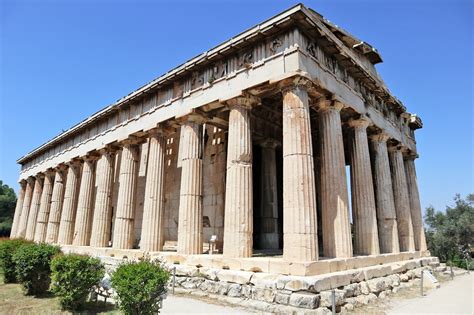Greece is a country steeped in history, with its ancient ruins serving as a testament to its rich and storied past. Among these timeless landmarks are the ancient Greek temples, which stand as magnificent reminders of the country’s architectural and cultural achievements. In this blog post, we will delve into the fascinating world of ancient Greek temples, exploring their rich history, architectural design, mythology, and beliefs. We will also discuss the importance of preserving and restoring these incredible ruins, and what visitors can expect when embarking on a journey through time at these revered sites. Join us as we uncover the allure and mystique of the ancient Greek temples, and discover the profound impact they continue to have on modern-day Greece.
The Rich History of Ancient Greek Temples
Ancient Greek temples are a testament to the rich history and cultural significance of the ancient Greek civilization. These architectural wonders were not merely places of worship, but also served as centers of community and culture.
The construction of these temples dates back to as early as the 6th century BCE, and they were dedicated to various Greek gods and goddesses, such as Zeus, Athena, and Apollo. The intricate and ornate designs of these temples reflected the importance of religion and spirituality in ancient Greek society, and the impressive ruins that remain today provide a glimpse into the past glory of these magnificent structures.
Moreover, the architectural achievements of these temples played a significant role in shaping the development of Western architecture, influencing later styles such as the Romanesque and Gothic periods. The use of columns, pediments, and friezes in Greek temple design has had a lasting impact on architectural traditions throughout the centuries.
Today, the preservation of ancient Greek temples is a priority for historians, archaeologists, and cultural preservation organizations. Efforts to protect and restore these historical sites are crucial in order to maintain their legacy for future generations and ensure that they continue to serve as symbols of ancient Greek civilization and architectural brilliance.
Exploring the Architectural Design of Greek Temples
Ancient Greek temples are known for their impressive architectural design, which still captivates people today. The architectural design of these temples reflects the skill and craftsmanship of the ancient Greek builders, as well as the cultural and religious significance of these structures.
The structure of Greek temples typically followed a standard design, with a front portico supported by columns, a main chamber or cella, and a rear chamber known as the opisthodomos. The use of columns, including Doric, Ionic, and Corinthian styles, was a defining feature of these temples, adding to their grandeur and visual appeal.
Additionally, the layout and orientation of Greek temples were carefully planned to align with the movement of the sun and stars, emphasizing the connection between architecture, nature, and spirituality. The design of these temples created a sense of harmony and balance, reflecting the ideals of the ancient Greek civilization.
Visiting these ancient sites allows us to appreciate the ingenuity and creativity of the architects and builders who constructed these remarkable structures, as well as gain insight into the religious and cultural practices of the ancient Greeks.
Unveiling the Mythology and Beliefs Surrounding Greek Temples
Unveiling the Mythology and Beliefs Surrounding Greek Temples
When we think of ancient Greek temples, we often picture grand structures dedicated to the gods and goddesses of Greek mythology. These temples were not only architectural wonders, but also held deep significance in the religious beliefs and practices of the ancient Greeks.
One of the most prominent beliefs surrounding Greek temples was the idea of the sacred, or temenos, which referred to the sacred space surrounding the temple where rituals and sacrifices were performed. This concept was integral to the religious practices of the ancient Greeks, as it symbolized the connection between the mortal world and the divine realm.
The mythology surrounding Greek temples also played a key role in shaping the beliefs and rituals of the ancient Greeks. Each temple was dedicated to a specific deity, and the stories and legends associated with that deity influenced the practices and ceremonies that took place within the temple grounds.
Furthermore, many ancient Greek temples were built in locations that were believed to be sacred or significant in Greek mythology. For example, the Temple of Apollo at Delphi was constructed at a site believed to be the center of the world, according to Greek mythology. This connection to mythology added an extra layer of spiritual and cultural significance to the temples.
Preserving and Restoring Ancient Greek Temple Ruins
Ancient Greek temple ruins are an invaluable part of our cultural and historical heritage, and efforts to preserve and restore them are crucial in maintaining a connection to our past. These magnificent structures, originally built to honor various gods and goddesses, serve as a testament to the advanced architectural and artistic skills of the ancient Greeks.
Preservation of these ruins involves careful maintenance, protection from natural elements, and the prevention of further deterioration. In addition, restoration efforts aim to recreate the original appearance of the temples, giving visitors an authentic glimpse into the past.
Conservationists and archaeologists work tirelessly to ensure that these sites are protected for future generations to appreciate and study. Their dedication to preserving and restoring ancient Greek temple ruins is a labor of love, as they understand the importance of these cultural landmarks in shaping our understanding of the past.
Visitors can participate in this preservation effort by respecting the historical significance of these sites and adhering to guidelines for responsible tourism. By working together to protect these ancient treasures, we can ensure that they remain a window to the rich history and achievements of the ancient Greek civilization.
Visitor Experiences: A Journey through Time in Greek Temple Ruins
When visiting the ancient Greek temple ruins, visitors are immediately transported back in time to an era of rich mythology and grand architectural design. The experience of wandering through the ruins allows individuals to immerse themselves in the history and beliefs of the ancient Greeks. The sheer magnitude of the temples and the intricate details of their construction leave visitors in awe of the skill and dedication of the architects and builders of the time.
As visitors explore the temple ruins, they have the opportunity to gain insight into the mythology and beliefs of the ancient Greeks. Each temple has its own unique story to tell, and by walking through the ruins, visitors can gain a deeper understanding of the religious practices and rituals that were an integral part of ancient Greek society.
Preserving and restoring these ancient temple ruins is crucial in order to provide future generations with the opportunity to experience and appreciate the history and culture of the ancient Greeks. By protecting these sites, visitors can continue to embark on a remarkable journey through time and gain a greater appreciation for the legacy of the ancient Greeks.
Ultimately, the visitor experience at Greek temple ruins is a unique and enlightening journey that offers a glimpse into the rich history and mythology of ancient Greece. It is a chance to step back in time and gain a deeper understanding of a civilization that has had a lasting impact on the world.
Frequently Asked Questions
What is the history of ancient Greek temples?
Ancient Greek temples have a rich history dating back to the 8th century BCE. They were built as places of worship for the ancient Greek gods and goddesses.
What is the architectural design of Greek temples?
Greek temples are known for their distinctive architectural features such as columns, pediments, and friezes. The most famous example of Greek temple architecture is the Parthenon in Athens.
What mythology and beliefs are associated with Greek temples?
Ancient Greek temples were associated with various myths and religious beliefs. They were believed to be the dwelling places of the gods and were central to religious rituals and festivals.
How are ancient Greek temple ruins preserved and restored?
Preservation and restoration efforts for ancient Greek temple ruins involve meticulous archaeological work, conservation of existing structures, and in some cases, reconstruction of missing elements based on historical and archaeological evidence.
What is it like to visit ancient Greek temple ruins?
Visiting ancient Greek temple ruins offers a unique opportunity to experience the history and culture of the ancient world. Visitors can explore the architecture, learn about the religious practices, and immerse themselves in the atmosphere of ancient temples.
What are some famous ancient Greek temples to visit?
Some of the most famous ancient Greek temples to visit include the Parthenon in Athens, the Temple of Apollo in Delphi, and the Temple of Hera in Olympia.
Why are ancient Greek temples considered timeless ruins?
Ancient Greek temples are considered timeless ruins because they continue to inspire awe and fascination with their architectural beauty, historical significance, and cultural impact, even thousands of years after their construction.






